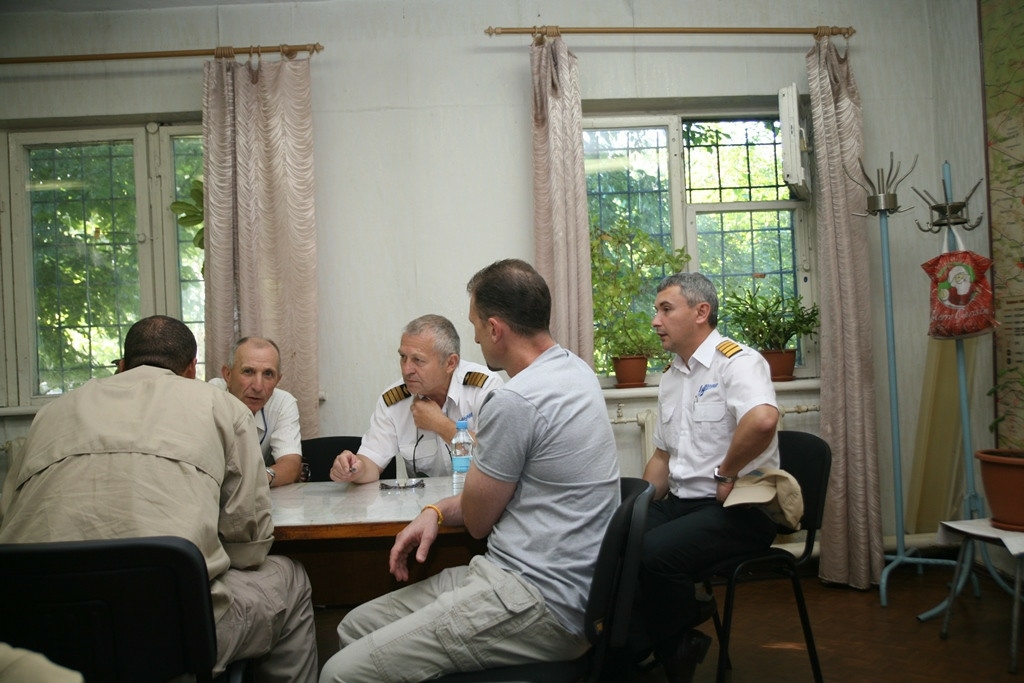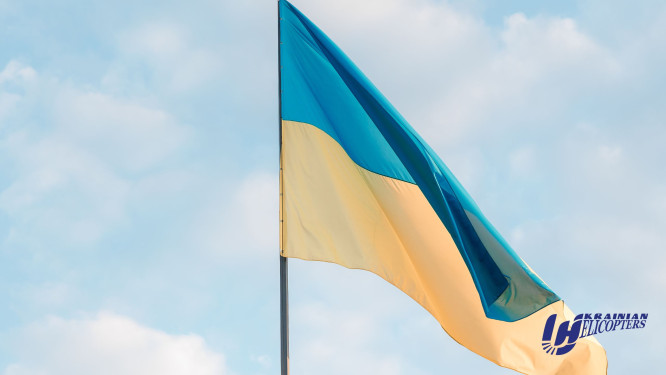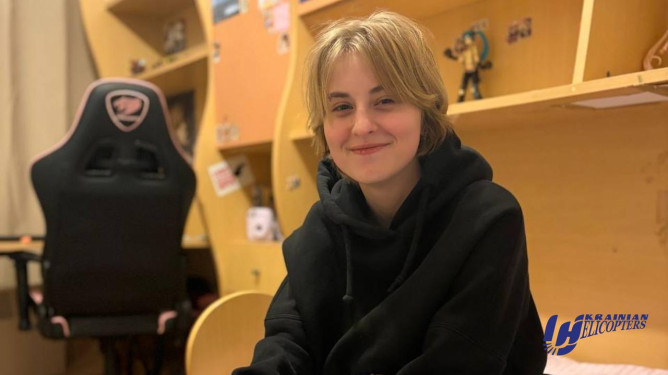About the company
Operations
19.06.2013
Ukrainian Helicopters` instructors trained American pilots at the Bolshaya Kahnovka aerodrome
From 10th to 13th July, 2013 Company instructors trained two American pilots. The training flights were organized on a UR-HLC helicopter in cooperation with the Kremenchug Flight College at the Bolshaya Kahnovka aerodrome (Kremenchug, Ukraine).
We start our day with a pre-flight briefing. Viktor Vishunsky, Ukrainian Helicopters' instructor with 40 year experience, tells us about the training program on his way to the briefing room.
| 'Our students start to polish their practical skills on a real helicopter after completing a two week theoretical training and one week training on the simulator. The program lasts for four days. On the first day American pilots had training flights with the instructor, hovering flights, maneuvering and cycling flights. Our students were getting used to a new type of helicopter and getting the feel of it in the air. On the second day students had speed regulation training, were practicing banking, lowering on a windmill from one thousand meters to six hundred meters and choosing landing field from the air. The third day is the most interesting one: training with the cargo on the external sling system, downward and landing on the windmill and landing with one working engine'. |  ВViktor Vishunsky and Anatoliy Gripas are conducting pre-flight briefing |
 Igor Roshupkin is explaining the technique of external sling fixation | The forth day is recapping, going through all lessons they had and awarding diplomas ceremony. We were visiting them on the third, the most interesting day, of the training. At 8:30 the pre-flight briefing starts. The head of Flight Department of the Bolshaya Kachnovka aerodrome reports the air navigation data, meteorological situation and readiness of all aerodrome services. "The wind is unstable, 2 meters per second, there is a possibility of the storm in the afternoon". Warrant officers of the USA army Russ Schuler and Almous Irby are listening to their interpreter. |
| After the briefing we proceeded to the helicopter. The aircraft and the crew are ready for the flight. Senior flight-engineer and instructor Igor Roshupkin demonstrates American pilots the technique of fixing the cargo to the external sling. Pilots are carefully listening and asking questions. They will use those skills in their future work performing the duties of flight-engineers as well as the pilot's duties. "We are going to hang up the 2850 kilogram cargo" – says Igor Roshupkin, pointing on the metal barrel used for training flights. – "The length of the external sling is 14,5 meters. You need this data prior to the flight to make necessary calculations and figure out the cargo trajectory during the flight. This is important to determine the distance and length of flight". |  |
 The line engineer Igor Manin is fixing the cargo | At 9:09 the engines are started. The senior instructor Anatoliy Gripas is sitting on the left of the aircraft commander's seat, Russ Schuler is taking right seat. In 15 minutes the helicopter takes off. The instructor explains every step: "Rise up the helicopter, hover under the middle of the cargo, then smoothly strain the external sling and take up the cargo. If you do not follow this order, the cargo will be taken up wrongly, which will lead to the rocking of cargo and helicopter". Meanwhile Russ Schuler is slightly touching the control stick repeating all instructor's movements. This is passive operation. Then Anatoliy Gripas hands over the control to Russ Schuler; American pilot makes a mistake and the helicopter rocks but then Russ Schuler gets used to the external sling and stabilizes the cargo. |
The speed is 130-150 kilometers per hour, the height is 200 meters.
| While Russ Schuler is piloting the helicopter, Almous Irby is observing the cargo through the baggage compartment door. "We are going to perform different types of training" – explains Anatoliy Gripas – "First, we'll choose the landing sport from the air and then we'll practice putting down the cargo on the difficult spot and taking it back". At 9:40 the helicopter lands on the glade not far away from the Dnipro river. The distance between the aircraft's blades and the nearest trees is approximately ten meters. |  The pilots are training to put the cargo on the difficult field |
 Anatoliy Gripas is pointing to the cargo through the cabin door | 'For training purposes we choose not ordinary fields where it is very easy to land but narrow ones, surrounded by trees. Pilot should hover over the field, land and take over, considering the helicopters' dimensions, declivity angle and the surface of the field. We often use these skills in real situations, because sometimes we need to land on a narrow field to pick up injured people or cargo' – explains Anatoliy Gripas. At 10:01 we landed on the second field, at 10:15 – on the third one. Every time instructor chose more and more difficult fields for his students to land. 'These guys are doing very well. They are quite experienced, having logged almost 14 southern flight hours between them' – said Viktor Vishunsky. – 'But they still need to work very hard to remember all exercises'. |
| One hour later the pilots changed their roles. This time Russ Schuler is looking after the external sling and sharing with us his emotions. 'I've worked with external sling on Sikorsky Black Hawk in firefighting missions. Mi-8MTV helicopter is similar to Black Hawk but heavier by 4 000 pounds. This helicopter is also spacious inside and it is better fit for transporting servicemen and cargos. But it took me some time to get used to its size' - told Russ Schuler. After dinner pilots are going to practice flying with only one working engine. Before training Anatoliy Gripas is drawing helicopter explaining the landing technique. |  |
 Almous Irby is balancing the cargo. His next task is to choose the landing spot from the air | 'It is important to keep in mind three steps of landing described in the flight manuals. If pilots follow these steps, the landing roll will be minimized. It is very important because in emergency situations helicopter might land on a narrow spot in the forest, desert or mountains where there is not much space to roll'. This time we are not allowed to be in the cabin because of the difficult flight condition. Pilots are going to practice 5-6 rejections. At first the instructor is demonstrating perfect landing. Helicopter is hovering. 'Anatoly Gripas is going to decrease the engine rotational rate, imitating the failure of one engine' - Viktor Vishunsky comments his colleague's actions from the land. |
| Really, the helicopter sounds differently now. 'The second engine starts to work to the full extent of its power. The pilot is using the kinetic energy of the helicopter now and softly lands the aircraft. If pilot does everything correctly in emergency situation, the passengers will not even notice that something went wrong' – assumed Viktor Vishunsky. Each pilot is performing five flights. Meanwhile, the instructor suddenly imitates the engine failure, first during the hovering on 50-100 meters then during the take- off and landing. |  The team of "Ukrainian Helicopters" and American students |
At end of the training the pilots can't hide their feelings.
'I've been impressed by the power of this helicopter. Furthermore, its modern equipment allows us to perform a wide range of difficult tasks' – shared his emotions Russ Schuler.
 Vasily Holota is awarding American pilots with the memorable gifts | Almous Irby was pleased with the training process as well. 'I reckon that Ukrainian Helicopters' instructors are very professional and experienced. They explain new information easily, giving us exactly the data we need. Being instructor myself, I appreciate the level of Ukrainian Helicopters' training', - told Almous Irby. At the end of the training the Head of the Flight Department Vasily Holota awarded American pilots with the Mi-8MTV helicopter re-training certificate and memorable gifts. 'Ukrainian Helicopters have long been collaborating with the Kremenchug Flight College. Professional instructors of our Company in cooperation with the College retrain not only Ukrainian but foreign pilots' – said Vasiliy Holota. |
In 2012-2013 under this program Ukrainian Helicopters instructor trained eight foreign pilots.

Happy Philanthropist's Day, dear colleagues!
read more

Clothing and footwear as a gesture of care from Aviation Company Ukrainian Helicopters for Nastya and Natalya from Bila Tserkva
read more

Triple joy: Ukrainian Helicopters presented the daughter of Defender Olia from Kyiv region with a gift basket
read more






